I suppose saying that your gardening methods are mostly organic is like saying you’re slightly pregnant. If you’re a total purist this is a yes/no sort of thing. I try to keep away from most chemicals, but every now and then something pushes me off the wagon.
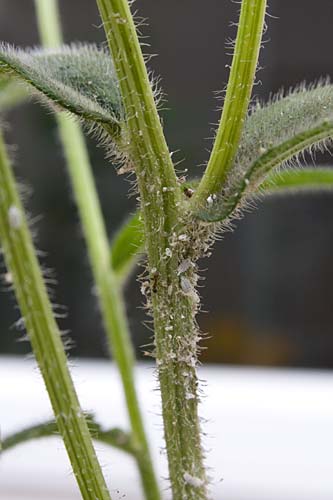 A few days ago I discovered that there was a sudden and massive infestation of mealybugs on one of my plantings of green-eyed gloriosa daisies, Rudbeckia hirta. In addition to the mealybugs, there was a major trail of ants going into the bed.
A few days ago I discovered that there was a sudden and massive infestation of mealybugs on one of my plantings of green-eyed gloriosa daisies, Rudbeckia hirta. In addition to the mealybugs, there was a major trail of ants going into the bed.
I’ve posted before about the symbiotic relationship some fungi and critters have with ants. Since then I’ve read how another critter–bumblebees–have been increasing their dependence on the honeydew produced by sucking insects, in this case, aphids. Apparently the bumblee population has crashed in Scotland, likely because of habitat loss that has destroyed many of the plants they depend on. To compensate, the bumblebees have been visiting plants infested by aphids and feeding off the sweet goo the smaller critters produce. The aphid goo, however, lacks the essential proteins that plant nectar provides the bees, and the bees are suffering even more.
In dealing with my ant-mealybug problem I didn’t want to use a bunch of poisons, partly out of principle, partly out of the fact that the affected plants sit right outside the kitchen window–not a place I wanted a pile of toxics.
My solution to this problem was two-pronged: try to control the ants that were cultivating the mealybugs, and reduce the number of mealybugs on the plants to give them a fighting chance.
I’ll start with the mealybug control steps because that was the organic part. You can knock down mealybug populations to a certain extent using a strong blast of water. You can also use a non-toxic substance like insecticidal soap. With people heading over to the house this holiday weekend, I opted for the latter approach, hoping the control would be quicker and more thorough. A thorough squirt to cover stems and leaves–top and bottom–has reduced their number considerably. I’ll repeat in a couple of days to try to drop the population further.
The ant control part was more difficult. Some species can be controlled by a mixture of borax and sugar left near their trails, but unfortunately my ants didn’t care for my cooking. Dishwashing detergent mixed up with water can sometimes be poured onto their nests to control many of the ants that come in contact with it, but effects don’t last long. Ants dislike cucumbers, so you can sometimes keep them away by spreading cucumber peelings. But once again, that can have limited effects.
So out came the barrier spray that I used once this year to keep them out of the house after everything else failed. The hardscape around the plants got a quick perimeter line of the stuff, as did a couple spots where the ant line crossed some bricks. A quick touchup a couple days later and so far they seem under control.
So, yes, I did let a few squirts of chemicals into the garden, but compared to spraying the plants all over with something poisonous, this seemed like a reasonable compromise.
So is this organic? Not really. But it’s a good way to reduce dependence on chemicals by taking a more systematic approach to pest control.

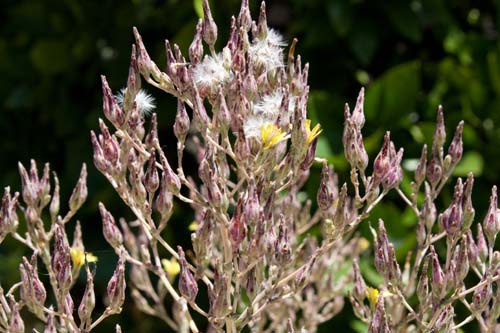

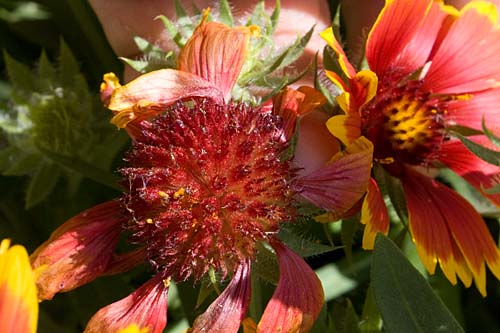 Of these two flowers, the one on the left is ready to be removed.
Of these two flowers, the one on the left is ready to be removed. A week’s worth of spent flowers, ready for the recycling or compost.
A week’s worth of spent flowers, ready for the recycling or compost.
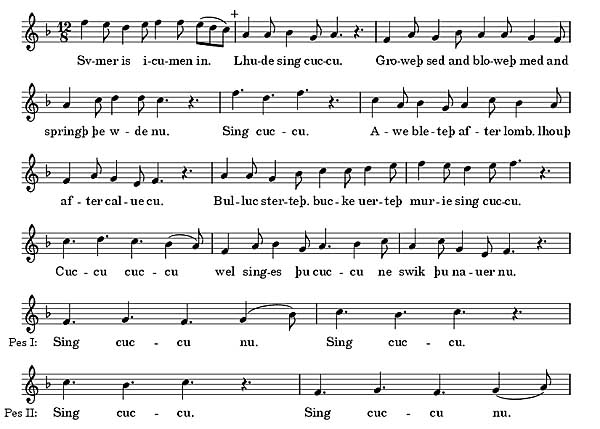

 I’ve said a couple unkind words against the mounstrously vigorous Mr. Stripey, but that’s the variety that bore first this year. The fruits so far have been small, about three ounces, sweet and extremely mild, with a very thin skin. The color is a rich, medium yellow, with dark rosy-red flushing to the fruits both inside and out. So far they don’t gush classic tomato flavor, but they’re still the best tomatoes I’ve had since last autumn’s farmer’s markets.
I’ve said a couple unkind words against the mounstrously vigorous Mr. Stripey, but that’s the variety that bore first this year. The fruits so far have been small, about three ounces, sweet and extremely mild, with a very thin skin. The color is a rich, medium yellow, with dark rosy-red flushing to the fruits both inside and out. So far they don’t gush classic tomato flavor, but they’re still the best tomatoes I’ve had since last autumn’s farmer’s markets.



 When I take my lunch break during the week and head to the gym, I follow a path that takes me by a small cluster of eucalyptus trees planted in a patch of lawn. Several of the trees have beautifully smooth trunks which are covered with a delicately mottled silvery bark. Once a year, usually late in spring or early in summer, the bark exfoliates, dropping off in small chunks that reveal the surprise: a bumpy, pale ocher layer of new bark underneath.
When I take my lunch break during the week and head to the gym, I follow a path that takes me by a small cluster of eucalyptus trees planted in a patch of lawn. Several of the trees have beautifully smooth trunks which are covered with a delicately mottled silvery bark. Once a year, usually late in spring or early in summer, the bark exfoliates, dropping off in small chunks that reveal the surprise: a bumpy, pale ocher layer of new bark underneath.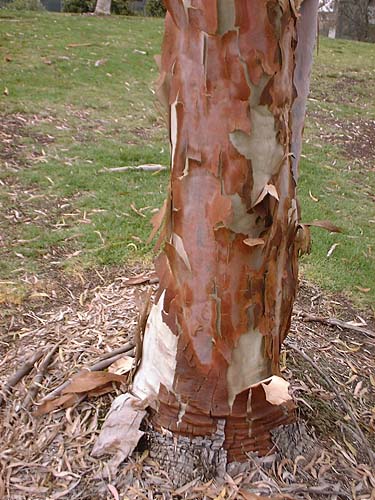 Another of the trees drops larger, thin, brittle sheets of red-brown bark, revealing a deliciously pale icy green below.
Another of the trees drops larger, thin, brittle sheets of red-brown bark, revealing a deliciously pale icy green below.

 Halfway across the yard, in a little clay pot, sits another variant of this species, the red form that’s been given the clonal name ‘Rosea,’ and is commonly known as “sticks of fire.” It’s supposed to be a lot less vigorous. It’s not supposed to get much over six feet tall. It’s supposed to lack the same amount of chlorophyll and have less of that life force than its green big brother. But I’m skeptical. That plant isn’t going to get to live outside of its pot. Ever.
Halfway across the yard, in a little clay pot, sits another variant of this species, the red form that’s been given the clonal name ‘Rosea,’ and is commonly known as “sticks of fire.” It’s supposed to be a lot less vigorous. It’s not supposed to get much over six feet tall. It’s supposed to lack the same amount of chlorophyll and have less of that life force than its green big brother. But I’m skeptical. That plant isn’t going to get to live outside of its pot. Ever.